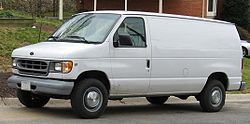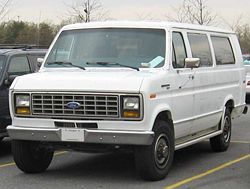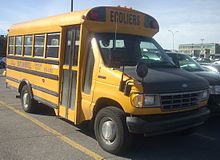- Ford E-Series
-
Ford E-Series 
Manufacturer Ford Motor Company Production 1961–present Assembly Avon Lake, Ohio, United States
Oakville, Ontario, Canada[1]Class Full-size van The Ford E-Series, formerly known as the Econoline or Club Wagon, is a line of full-size vans (both cargo and passenger) and truck chassis from the Ford Motor Company. The E-Series is related to the Ford F-Series line of pickup trucks. The line was introduced in 1961 as a compact van and its descendants are still produced today. The Econoline is manufactured solely at Ford's Ohio Assembly plant in Avon Lake, Ohio—after the closure of the Lorain, Ohio plant in December 2005 and the consolidation of all production at Avon Lake.
As of 2009, the E-Series and the 2010 model year Ford Transit Connect compact MPV, which had its debut at the 2008 Chicago Auto Show on February 11, 2009[2] are the only vans in the Ford lineup in North America.
The Ford E-Series currently holds 79.6% of the full-size van market in the United States with 168,722 sales in the United States in 2007.[3] It has been the best selling American full-sized van for 30 years (since 1980).
Contents
1961–1967 Compact Van
First generation (Flat Nose) 
Also called Mercury Econoline (Canada)
Ford Falcon Club WagonProduction 1961–1967 Body style 3-door van Layout FR layout Engine 144 cid I6
170 cid I6
240 cid I6Transmission 3-speed manual Related Ford Falcon The first E-Series was based on the compact Ford Falcon, sized roughly to compete with the 1961 Chevrolet Corvair Sportvan and Volkswagen Type 2, which was 172.3 in (4,376 mm) long. The first E-Series had a flat nose with the engine between and behind the front seats, later adopted by the Chevrolet Van and Dodge A100. Early models had a 144 cid 6-cylinder engine with a manual 3 speed transmission. Later models had a 170 CID or 240 CID engines with a 3 speed manual or automatic transmission. It was an immediate success with utilities like the Bell Telephone System. In the first 1961 model year, 29,932 standard vans, 6,571 custom Econoline buses, 11,893 standard pickups and 3,000 custom pickups were made. It was originally offered as a cargo van, an 8-passenger van with 3 rows of seats (which carried the Ford Falcon name) and as a pickup truck. A 165 lb (75 kg) weight was fitted over the rear wheels to balance the front-heavy vehicle, sometimes removed by current owners.
In rural Canada, where automobile dealers were scarce, the Econoline was sold alongside the M-Series truck lineup. Only the first generation of Econolines were sold as Mercurys; the next Mercury van of any type was the 1993 Villager minivan.
- First Generation Models 1961-1967
1968–1974
Second generation 
Production 1968–1974 Body style 3-door van Layout FR layout The 1968 Ford E-Series revolutionized van design by moving the engine all the way to the front under a short hood. These would be the first vans used as the basis for the now popular Class C van cab motorhomes, a class still dominated by Ford. The 1968 E-Series also used Ford's "Twin I-Beam" front suspension design, and was now available with a V8 engine. Over the next six years, the "Big Three" (GM, Chrysler and Ford) would all redesign their vans, with hoods gradually evolving to a short conventional truck-like hood, and evolving from being based on compact cars to using components from full-sized pickup trucks.
The grille was redesigned in 1971, and a year later E-Series offered a new feature, and a new model. Sliding rear doors were an option for 1972, as well as the Hi-Cube van, the first van with a stripped chassis used for something other than recreational vehicles.
1975–1991
Third generation 
Production 1975–1991 Body style 3-door van Layout FR layout Platform Ford VN platform Engine 300 CID I6
302 CID Windsor V8
351 CID Windsor V8
460 CID 385 V8
6.9 L Navistar diesel V8
7.3 L Navistar diesel V8Transmission 3-speed manual
4-speed manual
3-speed automatic
4-speed automaticWheelbase SWB: 124 in (3,149.6 mm)
LWB: 138 in (3,505.2 mm)Length SWB: 186.8 in (4,745 mm)
206.8 in (5,253 mm)
LWB: 226.8 in (5,761 mm)Width 79.9 in (2,029 mm) Height 79.2 in (2,012 mm)–85.4 in (2,169 mm) The E-Series was redesigned in 1975 with more ergonomic controls and a full frame, allowing it to be used as a truck chassis. This was the beginning of four wheel drive conversions for the van. The nose now had a proper hood, very close to the length used today. This bodystyle continued through 1991. In 1979 the front grille and headlights were facelifted and square headlights were incorporated. In 1983, Ford's "Blue Oval" logo was integrated into the front grille. Van conversions became a popular alternative to sparse factory passenger accommodations.
The basic appearance of the front end of this van was replicated for the Ford Ranger and its SUV offspring the Ford Bronco II.
A 1980 Econoline was the vehicle that accompanied, and provided accommodation for, Terry Fox when he undertook his Marathon of Hope across Canada. After providing transportation for other owners in its later life, from London, Ontario to a rock band based in Vancouver, British Columbia, it was recovered and restored by Ford Motor Company of Canada in 2008 and turned over to the Terry Fox Foundation to assist in further fund-raising activities.[4]
- Third Generation Models 1975-1991
1992–present
Fourth generation 
Production 1992–present Body style 3/4-door van Layout FR layout Platform Ford VN platform Engine 4.2 L Essex V6
4.9 L inline-6
302 CID Windsor V8
351 CID Windsor V8
4.6 L Triton V8
5.4 L Triton V8
6.8 L Triton V10
7.3 L Power Stroke V8
6.0 L Power stroke V8Transmission 4-speed automatic
5-speed TorqShift automaticWheelbase 138 in (3,505 mm) Length 1992–2008
Regular: 212 in (5,385 mm)
Extended: 232 in (5,893 mm)
2009–
Regular: 216.7 in (5,504 mm)
Extended: 236.7 in (6,012 mm)Width 79.3 in (2,014 mm)–79.9 in (2,029 mm) Height 80.7 in (2,050 mm)–84.1 in (2,136 mm) Curb weight 4,773 lb (2,165 kg) The redesigned 1992 E-Series was available with a 4.9 L inline six, 5.0, 5.8, and 7.5 liter V8 engines, or a 7.3 L Power Stroke diesel V8. The consumer-oriented Chateau Club Wagon version was Motor Trend magazine's Truck of the Year for 1992. The design was smoother and more aerodynamic, and the vans no longer wore taillight lenses that had been shared with Ford's F-Series trucks from 1973 to 1979.
With this body style, Ford dominated the market for 15 passenger vans once created by Dodge. It was favored by churches, but the high heavy-duty body became notorious for rollover incidents due to the high center of gravity and the weight of 15 adults. For this reason it is recommended that only trained drivers drive these vehicles and that nothing be carried on the roof of such vehicles. In recent years, some insurance carriers have required that the four-passenger seat in the last row be removed, reducing passenger capacity to 11. (For further information on this topic, see Rollover Safety.)
The only visible exterior change for 1995 was the deletion of the amber turn signals in the tail lights, used from 1992–1994. Models from Canada are ultimately renamed as E-Series, however the Econoline name continued until 2000 for the United States.
1997
The 1997 Econoline received an updated front end with a new grille that featured an oval cutout and new lower front bumper trim. Also new was an ergonomic dashboard layout containing dual airbags. Also introduced at this time were the new line of Triton V8 engines to replace the Windsors and the 460. The new lineup of engines featured a 4.2 L Essex V6, 4.6 L and 5.4 L Triton V8s, and a 6.8 L Triton V10. The 7.3 L diesel continued unchanged.
2001 E-Series
For 2001, Ford again refreshed the Econoline, with a new E-150 Traveler model targeted at families.
The Traveler would be a short-lived model, however, as minivans and SUVs were by this point far more popular for passenger use. But, as full-size vans have the towing and payload and optional diesel power of full-sized pickups and room for 8 to 15 passengers plus their baggage, a certain segment of customers continued to buy the E-Series (and, to a lesser extent, its competitors from GM and Chrysler).
For the first time on all models, the "E-Series" name replaced Econoline, and was sold as such in the literature on commercial vans and ambulance packages, another category dominated by Ford. Heavy-duty cutaway van models, most often used in large box vans and Class C recreational vehicles, also featured "E-350" or "E-450" badging on the front fenders.
2003
For 2003, Ford refreshed the E-Series by changing the grille style, incorporating an integral Ford logo. A new engine cover cup holder and glove box was also added.
2004 saw the replacement of the 7.3 L Power Stroke diesel and the introduction of the new 6.0 L Power Stroke with more power than the 7.3, but still detuned from the same engine in the F-Series due to a lack of airflow in the engine compartment. The 6.0 Powerstroke is intercooled, however the 7.3 L lacked an intercooler.
Inside, a new gauge cluster was also added, including a tachometer, along with a digital odometer.
In 2006, the 6.8 L Triton V10 produced 305 hp (227 kW; 309 PS) and 420 lb·ft (311 N·m) torque, 235/440 for the diesel.
A hydrogen-fuelled version of this engine powers an E-450 shuttle bus produced since 2007, used first in airports in Vancouver, British Columbia and Orlando, Florida.[5]
The E-series is a tow vehicle, due to the available GCWR (Gross Combined Weight Rating) of up to 20,000 lb (9076 kg), and its relatively low curb weight.[6]
95 percent of van sales are to commercial or fleet-end users, about half are cargo vans. The E-Series cargo area features a double-wall design — a full-size van exclusive — which leaves the exterior sheet metal less vulnerable to damage from shifting cargo.[7]
In early 2007, the E-series was listed by Autodata as one of the top 20 best-selling vehicles in the United States, most likely due to fleet sales. The competing models from GM have only been lightly updated since their 1995 redesign. Chrysler abandoned its Dodge Ram Van, a body style essentially unchanged from the 1970s, in favor of the Sprinter, a narrow European Mercedes-Benz van with a 150 hp (112 kW) turbodiesel engine, which has found favor primarily in commercial delivery with its high roof, and high-end, high-mileage Class C RV.
2008
Ford introduced the new E-Series at the New York Auto Show in March 2007. The van received completely redesigned front end sheet metal similar to that of the 2008 Ford Super Duty trucks. It has been overhauled with better handling and more payload.[8]
Updates to the front end of the van include larger headlights, a larger grille, and a longer hood than previously used on E-Series and Econoline vans. The 6.0 L turbo diesel is retained on the Super Duty E-series, while Super Duty F series received the new 6.4 L twin turbo diesel. Gasoline engines carried over. A series of upgrades to the braking, suspension and steering systems have resulted in improvements in ride and handling, braking performance and load carrying capability, although the Twin-I-Beam front suspension remains. Four-wheel drive is available through Ford Fleet Truck using current model year Super Duty parts.
The chassis and suspension improvements have also resulted in an increase in the maximum gross vehicle weight rating (GVWR) from 14,050 lb (6373 kg) to a class-leading 14,500 lb (6577 kg). Additionally, the maximum front gross axle weight rating (GAWR) is increased by about 10 percent, from 4,600 lb (2087 kg) to a class-leading 5,000 lb (2268 kg).
2009
In 2009 the E-Series received a new dashboard, complete with an available in-dash navigation system and upfitter switches as used in the F-Series Super Duty trucks. Also included is a passenger-side glove compartment, a first for the E-Series. Previously, the glove compartment was integrated in the engine cover.
Another new 2009 option was the rear-view backup camera, which is becoming widely available throughout the industry on smaller vehicles; it is another first for Ford in the full-size van field.
And finally, Ford is the first automotive manufacturer to offer a full-size van that is capable of using E-85; this option is most commonly available on Ford's F-150 with the 5.4 L engine. It was available on the 2009 4.6 L and 5.4 L engines.
2011
To celebrate its half-century mark, E-Series will feature a Special 50th Anniversary version for the 2011 model year.[9] The 6.0 diesel is also discontinued and replaced by Ford`s new 6.7 liter Powerstroke internally known as Scorpion. GCWR of the E450 has been raised to 22,000 lb (9979 kg), up from 20,000 lb (9072 kg).[10]
Replacement
Ford intends to replace the E-Series by 2014 with a global version of the fourth generation Transit platform developed by Ford of Europe. The Transit has been the E-Series' equivalent in Europe since 1965 and competes with the Mercedes-Benz Sprinter.
It is not known if the North American versions of the Transit will be equipped with turbodiesel power which makes up the vast majority of European sales. In order to introduce American buyers to Ford's Euro-vans, the company began importing the mechanically unrelated Transit Connect range for the 2010 model year.[11]
In 2011, the United Auto Workers confirmed the existence of a North American version of the Transit as the future product plans for the Ford Kansas City Assembly Plant were revealed. In late September 2011, Ford registered trademarks for Ford T-250, T-350, T-450, and T-550; the T-Series name will likely be used both as a continuation of the E-Series and to avoid similarity with the smaller Transit Connect.[12]Adventure
In 2005, a team of Icelander and British adventurers prepared a modified 6x6 Econoline for extreme ice conditions, brought it to the coast of Antarctica and crossed the ice cap to reach the South Pole in 70 hours, setting a new world record of overland travel to the South Pole.[13][14]
See also
References
- ^ "Plant Information: Oakville Assembly Complex". Media.ford.com. http://media.ford.com/plant_display.cfm?plant_id=101. Retrieved 2011-05-31.
- ^ http://www.media.ford.com/article_display.cfm?article_id=29829
- ^ "Crossovers, Lincoln highlight Ford's 2007 sales performance; further growth expected in 2008". Media.Ford.com. January 3, 2009. http://media.ford.com/article_display.cfm?article_id=27379.
- ^ "Ford hands over keys to Terry Fox's fully restored Econoline". Autos.canada.com. 2008-05-22. http://autos.canada.com/news/story.html?id=b39c214d-1a86-48b6-8bcc-a13e2ae94d41. Retrieved 2009-10-02.
- ^ McCausland, Evan (July 13, 2007). "Ford Hydrogen V10". Autoweek.com. http://www.autoweek.com/apps/pbcs.dll/article?AID=/20070713/FREE/70711005/1024.
- ^ "Ford RV and owing Guide". 2011. https://www.fleet.ford.com/truckbbas/topics/2011/2011_RV_and_Trailer_Towing_Guide.pdf.
- ^ "Ford Introduces The New 2008 E-Series Van". BlueOvalNews. March 7, 2007. http://www.blueovalnews.com/index.php?categoryid=12&p2_articleid=498.
- ^ "Ford Rolls Out Super Duty-Inspired 2008 E-Series Vans". Edmunds Inside Line. March 9, 2007. http://www.edmunds.com/insideline/do/News/articleId=119929.
- ^ "Ford’s E-Series Vans Celebrate 50 Years of Success; 2011 lineup features special anniversary edition". Media.ford.com. 2010-09-13. http://media.ford.com/article_display.cfm?article_id=33232. Retrieved 2011-05-31.
- ^ Ford 2011 What's New
- ^ http://blogs.automotive.com/6672004/miscellaneous/ford-transit-connect-to-replace-e-series-van/index.html
- ^ Berkowitz, Justin (October 4, 2011). "Full-Size Ford Transit Van Confirmed for U.S., May Be Called T-250, T-450, and T-550". Car and Driver. http://blog.caranddriver.com/full-size-ford-transit-van-confirmed-for-u-s-may-be-called-t-250-t-450-and-t-550/?utm_source=feedburner&utm_medium=feed&utm_campaign=Feed%3A+caranddriver%2Fblog+%28Car+and+Driver%29. Retrieved October 16, 2011.
- ^ Ice Challenger : World record for the fastest land crossing to the South Pole http://www.icechallenger.co.uk
- ^ South Pole 6x6 Ice Challenger http://www.4x4offroads.com/south-pole-6x6-ice-challenger.html
External links
- Ford E-Series official websites: U.S.A. | Canada
- Ford E-Series Ambulance Packages official websites (U.S.A.): Van | Cutaway Chassis
- Everything Econoline 61–67 Ford Econoline Site
- Vintage Truck Magazine 1962 Ford Econoline Van detailed article
- Ford Vans E series
- Mark's Econoline Page (Mainly about the 1961–1967 Econoline Pickups)
- Debut: 2008 Ford E-Series Vans (TheMustangNews.com – March 2007)
- 1968–74 Ford Van Site
- Ford Econoline in television and film
- camperize.com: info about converting the E-series into a campervan
- ThorMotorCoach.com: Major converter of E-Series chassis into motorhomes
Recent, current, and future vehicles, North American market from Ford Motor Company Passenger cars Crossover vehicles Sport Utility Vehicles Trucks/Vans - Courier
- Ranger
- F-Series
- Super Duty
- Transit Connect
- E-Series
Recently discontinued models
(2000s-present)Ford Motor Company light truck timeline, North American market, 1948–1979 — next » Type 1940s 1950s 1960s 1970s 8 9 0 1 2 3 4 5 6 7 8 9 0 1 2 3 4 5 6 7 8 9 0 1 2 3 4 5 6 7 8 9 SUV Bronco Bronco Coupé utility Ranchero Ranchero Ranchero Ranchero Ranchero Ranchero Ranchero Compact pickup Courier Courier Full-size pickup F-Series F-Series F-Series F-Series F-Series F-Series Van Econoline Econoline Econoline / Club Wagon Type 1980s 1990s 2000s 2010s 0 1 2 3 4 5 6 7 8 9 0 1 2 3 4 5 6 7 8 9 0 1 2 3 4 5 6 7 8 9 0 1 2 Mid-size crossover Edge Full-size crossover Freestyle Taurus X Explorer Flex Compact SUV Bronco II Bronco II Escape Escape Mid-size SUV Explorer Explorer Explorer Explorer Full-size SUV Bronco Bronco Bronco Expedition Expedition Expedition Excursion Expedition EL/Max Compact pickup Courier Ranger Ranger Ranger Ranger Mid-size pickup Explorer Sport Trac Explorer Sport Trac Full-size pickup F-Series F-Series F-Series F-Series F-Series F-Series Super Duty Super Duty Minivan Aerostar Aerostar Transit Connect Windstar Windstar Freestar Van Econoline Econoline/E-Series Categories:- Ford vehicles
- Mid-engined vehicles
- Rear wheel drive vehicles
- Vans
- School bus chassis
- 1960s automobiles
- 1970s automobiles
- 1980s automobiles
- 1990s automobiles
- 2000s automobiles
- 2010s automobiles
- Vehicles introduced in 1961
- Motor vehicles manufactured in the United States
- Automobiles powered by 10-cylinder engines
Wikimedia Foundation. 2010.















